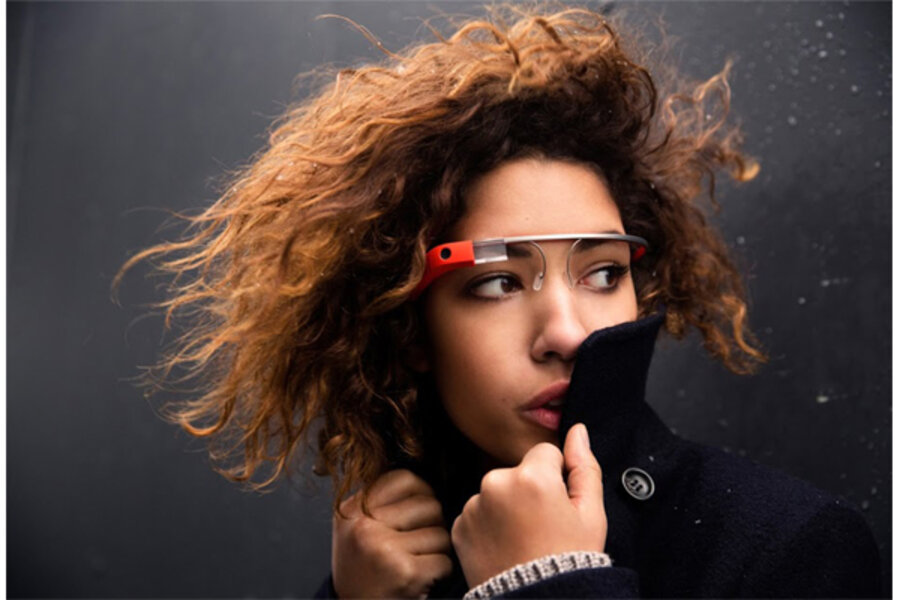Can high fashion save Google Glass’s image problem?
Loading...
In the fashion world, Google Glass has already reached the upper echelons of influence: last August it was featured in a 12-page spread in the iconic September issue of Vogue, and the device accessorized coral and turquoise garments at the Diane von Furstenberg runway show during New York’s Fall Fashion Week in 2012.
But the device hasn’t yet experienced the trickle down effect that usually sends trends rippling from the runways to the sidewalk. Though Glass is available in several titanium frames, and a partnership with Oakley and Ray Ban’s parent company is in the works, the wearable technology remains more technology than wearable – which has contributed to noticeable backlash from the public.
It is clear Google wants to change that reputation with the woman it just hired to head its Glass division: Ivy Ross. Ms. Ross is a former marketing executive with a resume that includes brands such as Calvin Klein and Coach, as well as Bausch & Lomb, a major eyewear company. Though Ross has little background in technology, the move indicates Google not only intends Glass to fit into normal street wear, but perhaps become the must-have technology as well as style accessory of the future.
“Can technology be something that frees us up and keeps us in the moment, rather than taking us out of it?” asks Ross in an open letter on Google+ announcing the job appointment. “Can it help us look up and out at the world around us, and the people who share it with us?... Glass is especially cool, as no one has really tried to answer [these questions] with a product like this before.”
Even Ross. The only time she has publicly mentioned technology more complicated than a website is when she indicated an interest in innovation at a 2013 Ted Talk. That being said, she does have a track record of combining design, marketing, and the retail experience at major successful companies. In addition to the brands listed above, Ross has worked with Swatch, Mattel, Gap, and most recently she was the chief marketing officer at Art.com, an online art retail site.
Not to mention, the first challenge she will likely face is one familiar to the retail world: price. Currently Glass sells for $1,500 -- about the same price as a MacBook Air. However, $1,500 is far less than many designer “it” handbags, such as the “Birkin” bag by Hermes. These handbags frequently fly off shelves within hours, and boast waitlists longer than lines outside Apple stores on the day of an iPhone release. Google likely hopes Ross, with a background in both mid-level and luxury brands, can find a way to frame the device in a way that makes Glass desirable, not out of reach.
And even though the economy has cut down on major purchases, the luxury goods market has actually maintained strong revenue. A report released by Deloitte on Thursday indicated that the world’s top luxury goods brands generated $171.8 billion in sales last year, and France, Italy, Spain, Switzerland, the United Kingdom, and the United States accounted for 90 percent of sales.
However, a Bain report from January indicated US luxury goods shoppers tend to be either “disillusioned,” meaning they suffer from luxury fatigue and tend to shop online, or “wannabe,” meaning they may be more middle class and buy what their friends or fashion publications tell them. This may pose a challenge for Glass, but certainly one Ross has already faced in the retail world.
That being said, the tech world is currently more concerned about Glass' utility. In an op-ed discussing Ross' hire at Google, Wired's Issie Lapowsky points out that if the device can't be sold to early adopters, it isn't likely to catch on with less tech-savvy audiences.
"When the audience at the recent TechCrunch Disrupt Conference in New York City was asked to raise their hands if they would wear Google Glass out in public, almost no one did, despite the fact that many of those audience members had tried the technology before," she writes. "I repeat: this was at TechCrunch Disrupt, where a little geekiness is virtually required for entry. This was not a perception issue. The thing just doesn’t work that well."
However, a New York Times article about Ms. von Furstenberg's runway show pointed out that bringing more women into the development process could help the perception with the "wannabes" referenced in the Bain report, as well as an audience that already feels confined to the outskirts of the tech world.
“Most of the people who stop me on the street are women,” Isabelle Olsson, lead industrial designer for Google Glass, told the Times in reference to wearing Glass in public. “Women have a different reaction than when they see some dude wearing it. It makes a difference seeing it on me.”
This isn’t the first time the tech world has tapped into the fashion world for help. Apple recently hired Angela Ahrendts, the former chief executive of Burberry, to head its retail division, and Paul Deneve, former chief executive of the Yves Saint Laurent Group, to work on special projects (many believe this means the much-rumored iWatch).
Rumors indicate Google hopes to get Glass to mass market by the end of 2014. This week, Google opened up sales of the current device to the public for an undetermined amount of time.








